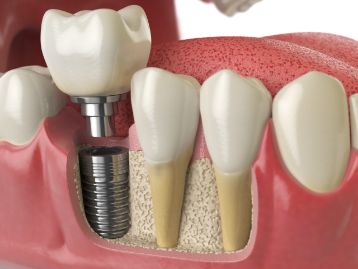
Did you know that the history of replacing teeth goes back 4,000 years, when people in China used bamboo pegs? Lucky for us, dentistry has changed a lot since then! Now, people have more options after tooth loss than ever before, including a bridge and dental implants. Both of these procedures are safe and reliable and offer their own set of benefits. But how do you know which one is right for you? Keep reading to find out!
The Pros and Cons of Dental Implants
Dental implants differ from a bridge because they replace the root of a missing tooth (as opposed to just the crown, or the white portion that you see above the gumline). This key factor accounts for many of the pros of dental implants, including:
- Superior strength, stability and chewing power
- Implants mimic natural tooth roots, which preserves your jawbone.
- Dental implants are particularly ideal when just one tooth is missing because they don’t affect the healthy adjacent teeth.
- Implants can last a lifetime with basic care.
- Implants are easier to maintain and keep clean. Just like natural teeth, you simply need to brush and floss as usual and schedule 6-month checkups.
Here are some of the drawbacks of dental implants:
- A higher cost upfront (although they’re likely to be more cost-effective in the long run)
- Implants require a small, in-office surgery.
- Implants also need several months to integrate or fuse with the surrounding jawbone before they can be completed.
The Pros and Cons of a Dental Bridge
Each person is different, and while implants are often a great choice, some patients may benefit more from a dental bridge. Here are some of the pros to consider:
- Less expensive initially
- Bridges can last 10-15 years
- A bridge procedure can be completed in just a few weeks
Here are some of the cons of a dental bridge:
- It requires grinding down and putting crowns on the two healthy teeth on either side to serve as anchors for the bridge.
- A bridge can be difficult to clean (special floss threaders must be used), which increases the risk for cavities on the anchor teeth.
- A bridge doesn’t replace the root of a missing tooth, which means the jawbone will deteriorate over time.
To know which option is right for you, a dentist will look at your medical and dental history, age, lifestyle, goals, and budget before making a recommendation. However, rest assured that regardless of what you go with, you’ll end up with a beautifully restored smile and great oral health.
About the Author
As an experienced family dentist, Dr. Joanne Bancroft knows it can be overwhelming to decide which treatment is best after tooth loss. To help her patients make the right decision, she always reviews the risks and benefits of each choice and answers any questions they may have. If you want to know more about replacing a missing a tooth or have any questions, you can reach Dr. Bancroft via her website.
